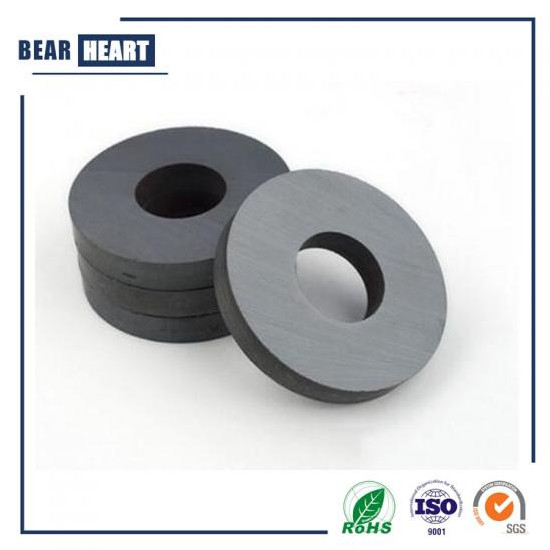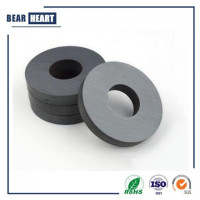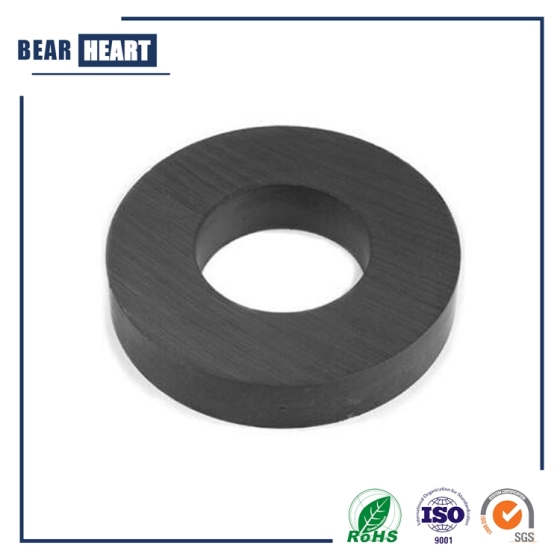
Ceramic Ferrite Ring Magnet
Ferrite magnets Features:
1) Cheapest magnet material
2) Good anti-corrosion performance, no need to surface treatment.
3) Best temperature stability
4) Best choice for industrial application
5) All shapes can be customized
6) provide isotropic and anisotropic
- Information
Professional Ferrite Manufacturer Permanent Y35 Ring Ferrite Magnet for Speakers
Ferrite magnet or ceramic magnet is the cheapest magnetic material available with the lowest cost/energy ratio, also known as Ceramic Magnets, they are mainly Strontium based (SrFe2O3), manufactured with Strontium Carbonate additive to increase performances from the obsolete Barium based (BaFe2O3).
Ferrite Ceramic ring magnets can operate in higher temperature applications where a strong magnetic field is not needed. Ceramic is low cost, but the lower magnetic field produced by ceramic / ferrite magnets requires a larger size to get the field required. Ceramic ring magnets are a dark charcoal gray in color and do not appear metallic. Ceramic magnets are not suited for high-temperature applications (over 250° C). Ferrite ring magnets are great for use in many applications, which include use as motor magnets, sensor magnets, hobby magnets, craft magnets, consumer electronics magnets, and speaker magnets.

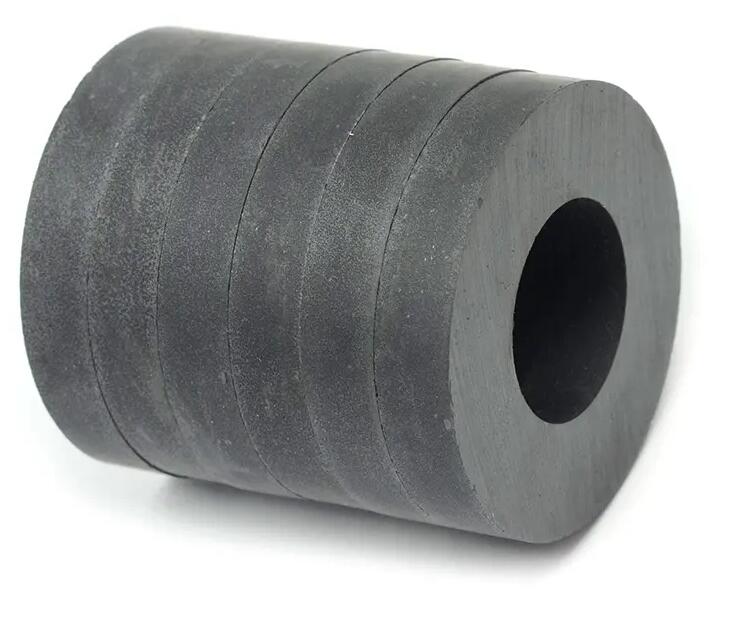
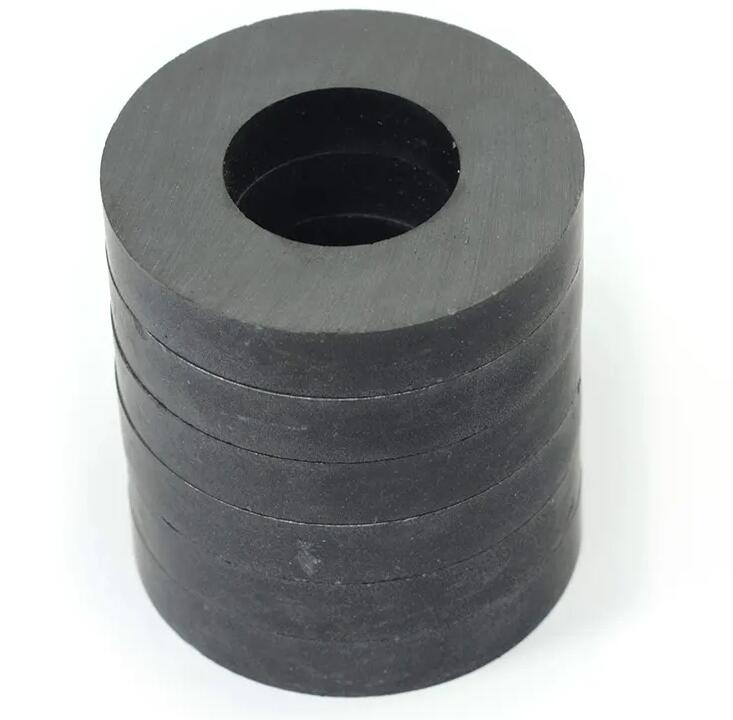
Features:
Dimensions: OD220.00 x ID110.00 x 20.00mm Thickness
Tolerances: +/-0.1mm
Material: Ferrite Ceramic C8
Plating/Coating: N/A
Magnetization Direction: Axially (Poles on the Flate Faces)
Inexpensive yet strong; a good balance between strength and affordability.
Does not demagnetize easily.
Can be magnetized with multiple poles if necessary.
Does not rust.
Key Challenges Of Ceramic Magnet Material
Hard and brittle.
Properties degrade linearly with temperature. At 350°F (177°C), about 75% of room temperature magnetization is retained, and at 550°F (288°C), about 50% is retained.

Ferrite magnets characteristics
Grade | Value(min/typical in our factory) | |||||||
Br | Hcb(BHC) | Hcj(IHC) | (BH)max | |||||
MT | KG | KA/m | Koe | KA/m | KOe | Kj/m^3 | MGOe | |
Y10T(=C1) | 200/218 | 2.00/2.18 | 125/145 | 1.57/1.82 | 210/250 | 2.64/3.14 | 6.5/8.0 | 0.8/1.0 |
Y25 | 360/370 | 3.60/3.70 | 135/150 | 1.70/1.88 | 140/170 | 1.76/2.14 | 22.5/25.3 | 2.8/3.2 |
Y30(=C5) | 380/385 | 3.80/3.85 | 191/210 | 2.40/2.64 | 199/220 | 2.50/2.51 | 26.0/28 | 3.4/3.7 |
Y30BH | 380/390 | 3.80/3.90 | 223/235 | 2.80/2.95 | 231/245 | 2.90/3.08 | 27.0/30.0 | 3.4/3.7 |
Y33 | 410/420 | 4.10/4.20 | 220/235 | 2.77/2.95 | 225/240 | 2.83/3.01 | 31.5/33.0 | 4.0/4.2 |
Y35 | 400/410 | 4.00/4.10 | 175/195 | 2.20/2.45 | 180/200 | 2.26/2.51 | 30.0/32.0 | 3.8/4.0 |
C8(=C8A) | 385/390 | 3.85/3.90 | 235/255 | 2.95/3.20 | 242/265 | 3.05/3.33 | 27.8/30.0 | 3.5/3.7 |
C10 | 400/410 | 4.00/4.10 | 288/300 | 3.62/3.77 | 280/287 | 3.51/3.60 | 30.4/31.9 | 3.8/4.0 |
Application:
- Speaker Magnets
- DC brushless motors
- Magnetic Resonance Imaging (MRI)
- Magnetos used on lawnmowers and outboard motors
- DC permanent magnet motors (used in cars)
- Separators (separate ferrous material from non-ferrous)
- Used in magnetic assemblies designed for lifting, holding, retrieving and separating
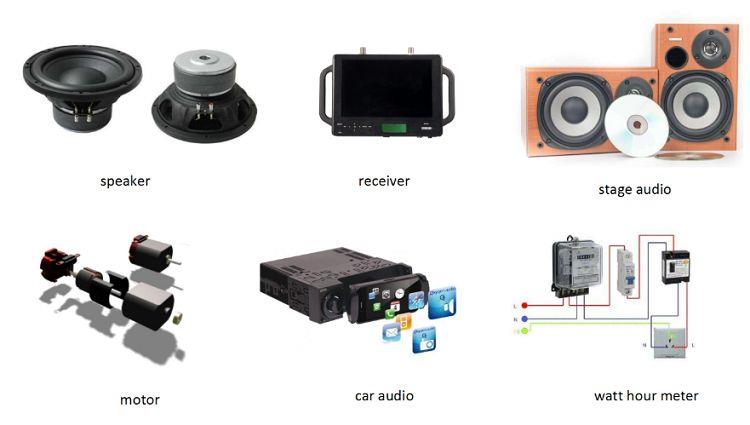
FAQ:
Q1. Can ring ferrite magnets be customized?
A1. Yes, ring ferrite magnets can be customized in terms of their size, shape, and magnetic strength to suit specific applications.
Q2. What is the temperature range for ring ferrite magnets?
A2. Ring ferrite magnets can operate in temperatures up to 250°C (482°F).
Q3. How are ring ferrite magnets stored and handled?
A3. Ring ferrite magnets should be stored away from other magnets and electronic devices that could be affected by their magnetic fields. They should also be handled with care to avoid cracking or chipping.
Q4. What is a Y35 ferrite block magnet?
A4. A Y35 ferrite block magnet is a magnetic material made from a sintered composite of iron oxide and strontium carbonate, with a specific magnetic energy rating of 35 MGOe.
Q5. What are the characteristics of a Y35 ferrite block magnet?
A5. Y35 ferrite block magnets have high resistance to demagnetization, good temperature stability, and high coercivity. They also have relatively low magnetic strength compared to other magnets.

